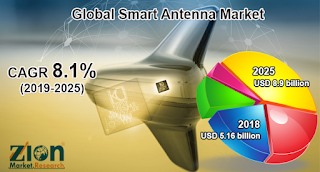Global Smart Antenna Market Size 2018: By Type, Applications, Technology, Industry Share, Demand, Market Size, Segments, Analysis and Forecast to 2025
Global Smart Antenna Market Size 2018: By Type, Applications, Technology, Industry Share, Demand, Market Size, Segments, Analysis and Forecast to 2025
Each of the antenna elements receives and processes its own signal, which is then merged and regulated to improve overall wireless system performance.
A wireless system's capacity can be increased by using these antennas, which can increase signal range, suppress interfering signals, battle signal fading, and so on.
Global demand for smart antennas in wireless communication and the increasing use of smart antennas in smart phones are the primary drivers of the global smart antenna market.
With features such as SMS and voice messages, multimedia functionality, internet apps, inbuilt GPS capabilities, and high data processing capabilities, smartphones have become a viable alternative to computers and personal digital assistants (PDAs).
Companies have been driven to improve wireless transmission efficiency as a result of the increased demand for quicker data transmission in current communication systems such as high-speed downloading, optimised evolution data, and web browsing. As a result of these factors, the demand for smart antennas is expected to rise throughout the projected period of 2015 to 2023.
SIMO (Single Input Multiple Output), MIMO (Multiple Input Multiple Output) and MISO (Multiple Input Multiple Output) are the three sectors of the worldwide smart antenna market (Multiple Input Single Output). In 2014, the most money was made via MIMO (Multiple Input Multiple Output).
There are three basic types of MIMO functions: pre-code, spatial multiplexing, and diversity coding. Because of this, MIMO is able to utilise both SIMO and MISO capabilities at the same time.
Compared to SISO and MISO, MIMO technology provides a considerable advantage of enhanced capacity. Because of this, Massive MIMO and Cooperative MIMO are becoming commonplace in all wireless communication systems.
The switching multi-beam antenna and the adaptive array antenna make up the majority of the market. A sizable portion of the antenna industry was dominated in 2014 by adaptive arrays. As wireless communication technology improves, so does the need for more sophisticated antennas.
The global market for Wi-Fi systems, WiMax systems, cellular systems, RADAR, and others is broken down into five areas. When it comes to cellular networks, such as the Universal Mobile Telecommunication System (UMTS), Long Term Evolution (LTE), and Wideband Code Division Multiplexing Access (WCDMA), smart antennas play an important role (W-CDMA). That's why mobile systems are projected to be the market's biggest growth area between 2015 and 2023.
There are four regions in the smart antenna market: North America, Europe, Asia Pacific and Rest of the World. (RoW). There were 30.4 percent of total revenue generated in 2014 by North America, followed by Europe. Over the course of the forecast, this trend is projected to continue.
In 2014, more than half of the worldwide smart antenna market was concentrated in these two areas. Key drivers driving the market include increasing applications in technologies such as ultra wideband and radio frequency identification, among others. During the forecast period, Asia Pacific is expected to be the fastest-growing region.


Comments
Post a Comment